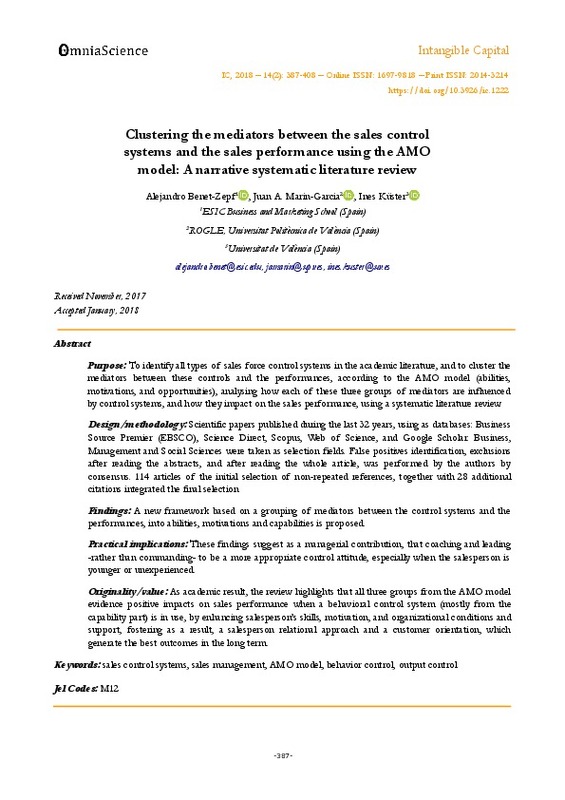JavaScript is disabled for your browser. Some features of this site may not work without it.
Buscar en RiuNet
Listar
Mi cuenta
Estadísticas
Ayuda RiuNet
Admin. UPV
Clustering the mediators between the sales control systems and the sales performance using the AMO model: A narrative systematic literature review
Mostrar el registro sencillo del ítem
Ficheros en el ítem
| dc.contributor.author | Benet-Zepf, Alejandro Teodoro
|
es_ES |
| dc.contributor.author | Marin-Garcia, Juan A.
|
es_ES |
| dc.contributor.author | Küster, Ines
|
es_ES |
| dc.date.accessioned | 2019-05-09T20:28:51Z | |
| dc.date.available | 2019-05-09T20:28:51Z | |
| dc.date.issued | 2018 | es_ES |
| dc.identifier.issn | 1697-9818 | es_ES |
| dc.identifier.uri | http://hdl.handle.net/10251/120248 | |
| dc.description.abstract | [EN] Purpose: To identify all types of sales force control systems in the academic literature, and to cluster the mediators between these controls and the performances, according to the AMO model (abilities, motivations, and opportunities), analysing how each of these three groups of mediators are influenced by control systems, and how they impact on the sales performance, using a systematic literature review. Design/methodology: Scientific papers published during the last 32 years, using as databases: Business Source Premier (EBSCO), Science Direct, Scopus, Web of Science, and Google Scholar. Business, Management and Social Sciences were taken as selection fields. False positives identification, exclusions after reading the abstracts, and after reading the whole article, was performed by the authors by consensus. 114 articles of the initial selection of non-repeated references, together with 28 additional citations integrated the final selection. Findings: A new framework based on a grouping of mediators between the control systems and the performances, into abilities, motivations and capabilities is proposed. Practical implications: These findings suggest as a managerial contribution, that coaching and leading - rather than commanding-to be a more appropriate control attitude, especially when the salesperson is younger or unexperienced. Originality/value: As academic result, the review highlights that all three groups from the AMO model evidence positive impacts on sales performance when a behavioral control system (mostly from the capability part) is in use, by enhancing salesperson's skills, motivation, and organizational conditions and support, fostering as a result, a salesperson relational approach and a customer orientation, which generate the best outcomes in the long term. | es_ES |
| dc.language | Inglés | es_ES |
| dc.publisher | Omnia Publisher SL | es_ES |
| dc.relation.ispartof | Intangible Capital | es_ES |
| dc.rights | Reconocimiento - No comercial (by-nc) | es_ES |
| dc.subject | Sales control systems | es_ES |
| dc.subject | Sales management | es_ES |
| dc.subject | AMO model | es_ES |
| dc.subject | Behavior control | es_ES |
| dc.subject | Output control | es_ES |
| dc.subject.classification | ORGANIZACION DE EMPRESAS | es_ES |
| dc.title | Clustering the mediators between the sales control systems and the sales performance using the AMO model: A narrative systematic literature review | es_ES |
| dc.type | Artículo | es_ES |
| dc.identifier.doi | 10.3926/ic.1222 | es_ES |
| dc.rights.accessRights | Abierto | es_ES |
| dc.contributor.affiliation | Universitat Politècnica de València. Departamento de Organización de Empresas - Departament d'Organització d'Empreses | es_ES |
| dc.description.bibliographicCitation | Benet-Zepf, AT.; Marin-Garcia, JA.; Küster, I. (2018). Clustering the mediators between the sales control systems and the sales performance using the AMO model: A narrative systematic literature review. Intangible Capital. 14(2):387-408. https://doi.org/10.3926/ic.1222 | es_ES |
| dc.description.accrualMethod | S | es_ES |
| dc.relation.publisherversion | https://doi.org/10.3926/ic.1222 | es_ES |
| dc.description.upvformatpinicio | 387 | es_ES |
| dc.description.upvformatpfin | 408 | es_ES |
| dc.type.version | info:eu-repo/semantics/publishedVersion | es_ES |
| dc.description.volume | 14 | es_ES |
| dc.description.issue | 2 | es_ES |
| dc.relation.pasarela | S\369976 | es_ES |








